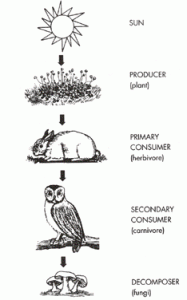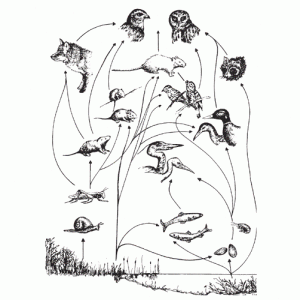Chapter 3
Commoner’s Laws of Ecology
“We travel together, passengers on a little space ship, dependent on vulnerable supplies of air, water, and soil, all committed for our safety to its security and peace: preserved from annihilation only by the care, the work, and I will say the love, we give our fragile craft.” — Adlai Stevenson
In the early 1970s, ecologist Barry Commoner wrote The Closing Circle, in which he discussed the rapid growth of industry and technology and their persistent effect on all forms of life. He suggested that we can reduce the negative effects by sensitizing, informing and educating ourselves about our connection to the natural world. Commoner summarized the basics of ecology into what he termed “laws of ecology.” Others have also used this idea to develop simple statements that help us understand and remember our connections to nature. Here are five laws of ecology:
- EVERYTHING IS CONNECTED TO EVERYTHING ELSE.
- EVERYTHING HAS TO GO SOMEWHERE or THERE IS NO SUCH PLACE AS AWAY.
- EVERYTHING IS ALWAYS CHANGING.
- THERE IS NO SUCH THING AS A FREE LUNCH.
- EVERYTHING HAS LIMITS.
These laws form the basis for studying and understanding the relationships and interdependencies found in communities and ecosystems. They further explain that humankind is, in fact, only one member of the biotic community and that people are shaped and nurtured by the characteristics of the land. These laws will not explain everything. Mysteries will remain. But they will give you a clearer understanding and appreciation of ecology, and your “niche” as a member of the living community.
LAW 1 — Everything is Connected to Everything Else
“When we try to pick out anything by itself, we find it hitched to everything else in the universe.” — John Muir
The basic message behind this law is that all things are connected to each other, sometimes in very obvious ways, and sometimes in very complex, indirect ways. To help illustrate this law, we will discuss food chains and webs, competition within communities, and the relationship between predators and their prey.
FOOD CHAINS AND FOOD WEBS
The essence of life begins with light from the sun. It continues with the transfer of this energy from sun to plant to animal. This series of links connecting organisms is called a “food chain.”
Food chains are simple models that illustrate food relationships between different organisms. All food chains have a common beginning: the sun’s solar energy Producers receive this energy and convert it into food for primary consumers (herbivores) and secondary consumers (carnivores).
Each species, including Homo sapiens, is a link in many chains. The rabbit eats many different plants, and the owl consumes other animals besides rabbits. Both animals are links in hundreds of chains. These interlocking chains comprise a “food web”. This tangle of chains seems confused and disorderly, yet in truth the web is highly structured and stable. When a strand of the web is altered or cut, many other strands are affected and must adjust. (Try Activity 36 — Web of Life (PDF).)
Figure 1. Movement of energy through a “food chain.”
Figure 2. This is a freshwater marsh food web. It illustrates the variety of food chains created by marsh inhabitants’ struggle for survival. Producers (submerged and emergent land plants pictured at the bottom of the drawing) are food for both primary consumers (insects, crustaceans and small fish) and omnivores (ducks, mice, rats, sparrows and raccoons). Secondary consumers include carnivores, such as fox and great blue herons. Top carnivores (marsh hawks and short-eared owls) feed on higher levels of the food chain.
Long, long ago, food webs were fairly simple, but through eons of time organisms have changed and numbers increased, creating more complex food relationships. Similarly, over hundreds or thousands of years, environmental changes have occurred. Because these changes were usually very gradual, organisms had time to adjust and adapt. Today, however, environmental changes are happening very rapidly. Habitats are being altered or destroyed over very short periods of time. Many organisms are finding it difficult to adjust to these changes. For the first time in history, food chains are getting shorter, rather than longer.
Ecologists and other natural resource experts are beginning to recognize that maintaining these complex food relationships and interdependencies is crucial for a healthy, biotic community. Instead of managing land for the benefit of one species, land managers are starting to consider diversity and balance in their management plans.
COMPETITION
Competition occurs between members of the same species and between different species competing for the same resources, such as food, shelter, mates, nest or den sites, or water. Competition is not always bad and can benefit the species in the long run. Here are some examples.
For moose, competition becomes intensified in early fall during the breeding season or rut. Why? Because bull moose are competing for the same resource: cows.
Only the larger, more dominant bulls will mate. It is not only the strength and size of the bull that decides who will mate and who will not, but also the size of their antlers. Bulls often fight, but rarely sustain serious injuries. Larger and more dominant moose will prevent younger, less experienced bulls from mating. In this way, only the genes from the strongest moose are passed on to the next generation.
Competition also occurs among plants. White oak saplings must compete for limited sunlight, and only the strongest ones will be able to get ahead of the others to capture the sun’s rays. Viewed as a whole, the white oak forest benefits because there are fewer plants competing for a limited amount of light, water and nutrients.
In competitions, there is often a winner and a loser. However, this is not always true. In New England, boreal spruce-fir forest are inhabited by five species of warbler (a small bird). They all eat insects, and appear to occupy the same niche — something that is not supposed to happen.
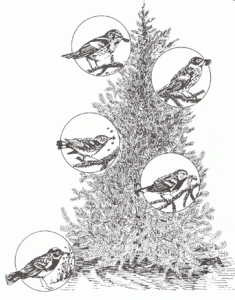
A detailed study of their feeding habits showed that these five warblers (myrtle, Cape May, blackburnian, black-throated green and bay-breasted) are able to share the same habitat because they have adapted their feeding behavior so that each species feeds at a different level in the tree canopy. These species also differ in the specific insects they eat and they nest at different times. Their unusual success at adaptation can be attributed to an earlier period of competition. These five species were able to alter their feeding and nesting habits enough to coexist peacefully.
Figure 3. These five warblers (myrtle, Cap May, blackburian, bay-breasted, and black-throated green) coexist in harmony in the white pine/hemlock forest by occupying separate niches.
PREDATOR-PREY RELATIONSHIPS
A special form of competition that occurs between two different species is the predator-prey relationship. A predator is an animal that captures and kills its prey. Predators often eliminate the weakest or diseased members of the prey species, leaving stronger members behind to reproduce and pass their genes on to the next generation.
The populations of predators and prey often “cycle,” with prey populations, increasing when predator pressure is low and decreasing when predator pressure is high. Think about it this way — when prey populations are high, predator populations are able to increase because there is abundant food for pregnant females and their young. As the number of predators increases, they consume more prey than can be replaced, and the prey population starts to decrease. With less food available, the predators are not able to feed their young and their population declines. As the predator pressure then decreases, more prey survive and their populations increase, coming around full cycle to the beginning again. These predator-prey cycles are normal, healthy and help maintain the strength of both species.

An often used example of the predator-prey cycle is the relationship between snowshoe hare and lynx in the northern United States and Canada. Trapping records of pelts shipped to Europe since the early I800s show that there are peaks, or highs, in the hare population every seven to nine years, followed by a “crash” and then a slow increase in the population leading to another peak. This pattern is the same for lynx, except that the peaks in the lynx population occur one year later than the peaks in the hare population. This suggests that the lynx are responding to the abundant food supply. More recently, it has been discovered that the food of the hare is involved in the cycle, too. As the hare populations increase, they eat more and more food, particularly small willow. The willow responds to this “predator pressure” by producing a toxin that makes the willow inedible to the hare. This reduction in winter food, along with increased disease and competition for burrow sites, contributes to the crash in the hare population.
Figure 4. The predator-pry relationship between the Canada lynx and the snowshoe hare is a close one with both species dependant on one another for their survival. If the lynx disappears, the hare soon overpopulate the area, resulting in intensified competition, disease, and death. If the hare disappears first, the lynx will soon perish due to starvation. Seventy percent of the lynx’s annual diet is snowshoe hare.
LAW 2 — Everything Has to Go Somewhere or There is No Such Place as Away
This is one law that has become increasingly clear as we attempt to find ways to deal with the waste that we produce each day. The garbage truck takes our trash “away,” but where is that? Humans are not the only creatures who produce waste. Natural systems must deal with animals that have died and the leaves that fall each autumn, as well as waste products, such as feces. We are learning about recycling, but nature has been doing it for a long time.
LIFE-SUPPORT CYCLES
In any ecosystem, there is a limit to the amount of minerals, nutrients, air, water and soil that are available within the system, and the rate at which they can be imported from outside the system. These substances must be recycled to support the living members of the system. Any disturbance in these cycles can jeopardize the entire system.
Two of the most important cycles are the water cycle and the nutrient cycle. We will use them to take a closer look at the relationship between the living and non-living members of ecosystems. A third, very important cycle, is the carbon dioxide and oxygen cycle. We won’t be explaining it here, but it would make a good research project for you and your students!
Water Cycle
Seventy-five percent of the Earth’s surface is covered by water. Of this, 97 percent can be found in our oceans, two percent in the ice of glaciers and a mere one percent in freshwater rivers, lakes, streams and underground reservoirs. This one percent is all we have ever had, or ever will have, for drinking, washing, cooking, industry and other uses. How do we keep from running out of fresh water? Because of the water cycle. Water is constantly changing form and moving, from clouds in the sky, to the land and oceans, and back to the sky, in a constant, self-renewing cycle.
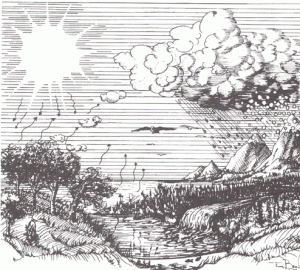
Powered by heat from the sun, water evaporates from lake, ocean and other surfaces into the air. Plants also release water into the air through transpiration, and animals release water into the air as they breathe. The gaseous water molecules are moved by wind. As the air moves upward, it cools and the water begins to condense, changing back into a liquid and forming clouds. When the clouds become over-saturated with water vapor, the water droplets are too heavy to remain in the sky and fall back to Earth as precipitation: fog, rain, snow, sleet or hail.
When precipitation reaches the ground, it may evaporate again, or it may be absorbed by plants or swallowed by animals, it may be stored in the ground, or it may runoff the surface into creeks and streams, and eventually into lakes and oceans. The cycle then repeats itself as the water evaporates again.
For millennia, the amount of water in the cycle has remained constant, and is never lost from the environment. The water molecules you drank today may have been drunk centuries ago by a dinosaur, a prehistoric human or a whale!
Nutrient Cycle
Each plant and animal has specific nutritional requirements for proper growth. They acquire the appropriate amount of each nutrient from minerals and elements that are continuously cycling through soils, water, air and living tissues. The most important nutrients are phosphorus, nitrogen, potassium, and calcium.
A key link in the cycling of nutrients is the decomposers: mushrooms, toadstools, fungi and bacteria. Decomposers break down dead plant and animal material back into simple compounds. This organic matter helps make the soil more fertile because it contains many minerals and nutrients necessary for vigorous plant growth. These plants are in turn eaten by herbivores that in turn are eaten by carnivores or omnivores. Without decomposers, the necessary minerals and nutrients
ENERGY FLOW
Unlike water, nutrients, and minerals, energy does not cycle in an ecosystem. Rather, energy enters an ecosystem and flows through it. An ecosystem is unable to create this energy and must rely on an outside source: sunlight. Every organism alive is dependent on the sun’s energy for its survival.
Energy is defined as the ability to do work. The energy from sunlight is captured by producers (plants) and changed into a form that is usable by other organisms in the ecosystem. Plants use the sun’s energy to convert nutrients, water, and carbon dioxide into plant tissue and hence, grow. Oxygen is released as a waste product and is available to be used by animals.
The only energy forms available to a plant-eating animal (herbivore) are the nutrients found in the tissues of plants. Herbivores, such as sparrows and deer, are referred to as primary consumers. These primary consumers are in turn eaten by meat-eaters or carnivores, and are called secondary consumers. These animals vary from small carnivorous insects like dragonflies, to large fish like trout, to mammals like bobcats. Occasionally, a food chain will include a second level of carnivores (tertiary consumers), for example bald eagles and humans. During each of these transfers, some energy is lost to the environment as heat.
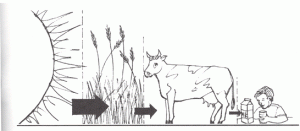
Figure 6. Energy is lost in creating milk. The energy of the sun fuels the growth of plants that are in turn consumed by the cow. The cow’s milk, which we consume, contains 1/1, 000 the caloric energy that was initially absorbed from the sun by the plants.
At each level in our food chain, the consumer is often restricted to a narrow selection of foods. For instance, if a great blue heron were to eat ants instead of fish, it would soon starve, because the heron would use more energy in pursuing ants than it would receive from eating them. Therefore, the further along the food chain a consumer is, the more efficient it must be at collecting food. For example, hawks, wolves, and trout consume only those prey species that provide enough energy to make it worth the effort to hunt, capture and eat them.
Another way to look at an ecosystem’s energy flow is with a food pyramid. The first layer, the producers, provides a foundation for the pyramid. Their numbers are the greatest because they must support all the other layers. In general, the number of animals in each successive layer of the pyramid decreases. Thus, for every carnivore there are hundreds of prey, thousands of secondary prey, millions of insects and uncountable plants.
Just as life-support materials cycle through ecosystems, so do toxins, like pesticides, herbicides, heavy metals and naturally occurring radioactive substances. Regrettably, Commoner’s Laws apply to unnatural, as well as natural, substances. Everything humans make and dispose of must go somewhere. Often these poisons go into the living tissues of plants and animals, including humans.
LAW 3 — Everything Is Always Changing
ECOLOGICAL SUCCESSION
The species of plants and animals that are found in a community do not remain the same forever. Rather, over long periods of time, they change, mainly because of the activities of the plants and animals themselves. This change is called ecological succession We can witness this change all around us as abandoned farmland changes to forest. This same process can be seen in an abandoned house lot in a city.

The first step in succession, called the pioneer stage, starts with lichens that grow on bare rock. Eventually enough soil is created to provide the nutrients needed to support the growth of grasses and herbs.
Figure 7. Stages in ecological succession, beginning with the pioneer invader species and progressing towards a mature climax and stable condition (primary succession).
Seeds from briars, shrubs, vines, and trees are blown or carried by animals or water into the site, where they eventually are able to germinate. Trees and shrubs soon start to grow, out competing the grasses and herbs and a new forest begins. Changes in the plants continue until a climax community, the last stage in succession, is reached. These communities are in equilibrium with their environment and are considered mature. In Maine, forest types that are examples of climax communities are:
- Spruce-Fir Forest
- Pine-Hemlock Forest
- Beech-Birch-Maple Forest
As one successional stage changes to another, the animal community also undergoes many changes. Rabbits, meadow mice and groundhogs find lush food in the grasses and herbs of early succession. As shrubs and trees replace the grasses and herbs, deer and grouse grow in numbers.
When the climax community, a mature forest, is reached, the white-footed mouse replaces the meadow mouse. Deer and grouse don’t use the mature forest as much, but turkeys, owls and squirrels do. The owl needs the mature forest for nesting and hunting, while squirrels need the mature trees for nuts, and acorns and dens. As changes in the landscape take place, whether natural or unnatural, animal life also changes.
ADAPTATION AND NATURAL SELECTION
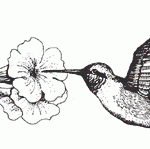
We have examined many ways that plants and animals interact with and depend on each other. We have looked at the movement of nutrients, food and energy through food webs. Competition between two species, as has previously been discussed, often results in the dominant species living in the best habitat, with the weaker species forced into less ideal habitat. Competition, whether between species or between individuals of the same species, results in the process of natural selection. The resulting changes in the species are called adaptations.
Figure 8. The hummingbird’s long bill, probing tongue and ability to hover are adaptations that allow it to feed on nectar of the honeysuckle. The honeysuckle is adapted with a long tube that causes the hummingbird to brush against the pollen as it feeds. As the hummingbird moves from honeysuckle to honeysuckle, the pollen is transferred and hence pollination (fertilization) takes place.
An adaptation can be 1) a physical or structural change, such as camouflage coloring, 2) a behavioral change, such as migration, or 3) a metabolic change, such as hibernation or estivation.
As individuals in the population experience success with an adaptation, they pass the trait on to their offspring. In time, adaptations become built-in tools that increase the chances of the organism’s survival.
Physical or Structural Change
Consider the noiseless wings of the owl, the spots on a fawn, the claws of a badger, the compound eye of a fly, a woodpecker’s beak, the large hind feet of a snowshoe hare or the placement of a frog’s eyes. These are all examples of how organisms have adapted and evolved physical structures to fit a specific niche in an ecosystem.
Behavioral Change
Brown creepers and red-breasted nuthatches are similar, small, tree-climbing birds that feed on eggs, larvae and adult insects living on the bark of trees. The nuthatch moves down the tree eating food that it sees in that direction, while the creeper moves upward in search of food. They are eating the same kind of insects, but because of their feeding behavior, competition is decreased and both birds can coexist. This type of adaptation is a behavioral change.
Metabolic Change
Some animals are able to go into a state of dormancy to escape extreme temperatures, either hot or cold, in their environment, or scarce food supplies. Winter dormancy, called hibernation, and summer dormancy (estivation) are both examples of metabolic change.
LAW 4 — There Is No Such Thing as a Free Lunch
“We abuse land because we regard it as a commodity belonging to us. When we see land as a community to which we belong, we may begin to use it with love and respect.” — Aldo Leopold
The Earth, its ecosystems and its communities, have undergone millions of years of adaptation and change. Through eons of time these changes often increased the diversity of life and stability of the system. In the Earth’s early history, only catastrophic changes, such as volcanic eruptions, earthquakes, floods and meteor showers, disrupted the balance between plants, animals, decomposers, water or air. Then, approximately two million years ago, human beings entered the interconnected web of life and took center stage.
What has been the effect? In modern times, we have seen substantial changes in medical care, world-wide communication, modes of travel, computer capabilities, and other sophisticated technologies. Many of these have made our lives better and easier. But at what cost? These gains and advances have not come free, either in terms of dollars or in environmental stress.
To understand some of these costs, let’s examine a lunch purchased at a local fast-food restaurant. We will trace the path of each item from origin to consumer, and track some of the costs along the way. The lunch includes a toasted sesame seed bun, a one-quarter pound hamburger, a milk shake and French fries.
Toasted Sesame Seed Bun: To begin, a farmer must prepare the ground (often adding chemical and organic fertilizers), buy the wheat seed, plant it and care for the crop until it is ready for harvest. To protect the crop from insects, weeds and disease, a farmer often sprays with chemical pesticides and herbicides. The harvested wheat is shipped to the grist mill where it is refined and bleached. (The process removes the wheat germ and bran, thus lowering the nutritional value of the flour.) The flour is sold to the bun factory where chemicals are added to the flour to enhance flavor and retard spoilage. The buns are baked and then shipped to the restaurant. What are some of the costs to ourselves, others and the environment? Here are a few:
- Insects and weeds become resistant to chemicals when they are constantly exposed to them.
- The farmer may attempt to control insects by using more chemicals.
- Overuse of these chemicals may result in the excess being washed into streams during storms or seeping into groundwater supplies, contaminating them.
- Extra chemicals cost more money and larger doses destroy birds, mammals and other insects that the farmer doesn’t necessarily wish to kill.
- Overuse of fertilizers can also result in the excess running off into streams, lakes and ponds, causing subsequent algae blooms and resulting in depleted oxygen levels for aquatic life.
- Farmers risk exposure to chemicals that may cause temporary illness or, in extreme cases, permanent disabilities.
- The energy costs are enormous. Consider the following:
- The cost of running farm machinery for sowing, planting and harvesting.
- Transportation costs for moving raw, processed and finished products around the country.
- Energy, costs to run ovens, stoves and toasters to prepare the buns.
One-Quarter Pound Hamburger: Beef producers have found it economically advantageous to grow their beef in Central and South America and ship it back to the United States for use in fast-food restaurants. To raise beef, large tracts of tropical rain forests and local food crop areas are displaced. Costa Rica alone exports 42,000 tons of beef annually for fast foods. These countries have agreed to raise beef because it brings in money for the country’s government. What are the costs? Here are a few:
- Eliminating the South and Central American rain forests affects migratory bird populations by destroying habitats and homes. Many of these birds help control blackflies, mosquitoes and other pests during the summer months in Maine.
- In a few years, the cleared land is overgrazed and abandoned. Often, vegetation does not return for years. New forests may not return for decades. Local people suffer, because land they need to grow food crops is being used to grow beef for fast foods.
- Consider the energy costs:
- Transportation costs from the tropical rain forests to the processing plant and to the fast-food restaurant in Maine.
- The operation of the fryers to cook the burgers.
Milk Shake: Milk is produced commercially throughout the country and in several parts of Maine. Dairy cattle are usually kept in pastures, where they graze on grass. As with all other food items, there are many steps between the cow producing milk and your milk shake. If too many cows are allowed to graze in the pasture, they may strip off the vegetation from the land. What are the costs for the milk in the milk shake? Here are a few:
- Damage to plant life because of overgrazing will result in erosion. If the land is steep, the erosion will be great.
- During rainstorms, loose soil in pastures may be transported to surrounding streams and be lost.
The increase of soil in waterbodies is called siltation. Siltation reduces oxygen levels and may interrupt the life cycles of aquatic life. - Consider the energy costs:
- Milking of the cows, often done by electric machines.
- Heating, pasteurizing, cooling and homogenizing the milk into a finished product.
- Costs for packaging milk and transporting it to the restaurant.
French Fries: Because potatoes grow underground, they have different growth requirements than wheat. Potato blight is a fungus that can destroy the entire crop so the farmer may use several applications of fungicide to prevent blight. These chemicals, in large amounts, can cause problems similar to those discussed with the wheat crop. What are the costs? Here are a few:
- Excessive application of chemicals to curtail potato blight can result in the excess seeping into groundwater supplies and contaminating them.
- Oil to fry the potatoes is highly processed from the plant or animal to the final product. There are costs associated with the oil that we have not included here. There are also heath consideration concerning saturated fats, cholesterol and heart disease.
- Consider the energy costs:
- Because potatoes are grown in Maine, the cost of transportation is low.
- Energy to process the oil and operate the fryers.
Packaging: Our imaginary lunch came in several forms of packaging. The burger was in a styrofoam container, the milk shake in a waxed cup with a plastic lid and straw and the French fries in a paper bag. The styrofoam container is made from chlorofluorocarbons, which are partly responsible for the depletion of ozone layers in recent years. The ozone layer screens out harmful solar rays that cause skin cancer in animal life. Plastic and wax from the milk shake cup came from petroleum products — oil and coal tar — that are non-renewable. The process to convert the oil to a plastic lid and straw is a complex sequence of molecular changes that require additional energy inputs. In Maine, discarded plastics are becoming an increasing danger to marine wildlife, who die after eating or becoming trapped in the plastic.
Paper for the bag and the cup comes from trees. Trees go through many steps before they become paper for packaging food. Unlike petroleum products, wood products are renewable (they can be replaced relatively quickly).
When we discard the waste from our lunch, we should consider where it goes. Some items can be recycled. Others are taken to an incinerator and burned to create electrical energy. Some items will be taken to a landfill and buried. How long will it take to decay? If you were to dig it up in a year, five years, I0 years, 50 years, which products would remain? Why?
It’s clear from this example that everything we do on the Earth has costs, some less obvious that others. You can trace all modern conveniences and products back to their environmental origin and predict their future course. Some of our activities, such as trash disposal and groundwater contamination, have disrupted the natural ability of ecological systems to maintain themselves.
The costs of our changes and alterations to the environment need to be considered along with the benefits. We have learned that ecosystems are complex and maintain a delicate balance. Understanding how our choices affect the environment can help us make better decisions about our use of natural resources.
LAW 5 — Everything Has Limits
For many years, it was believed that there was no end to what we could take from the Earth. There were always more fish in the sea, more trees to be cut, more ore to be mined, more earth to be tilled, and more places to dump our trash. We now realize that this is not true. Some resources, called renewable resources, can be replaced if conditions are suitable and there is enough time, energy and nutrients available. Renewable resources include trees, wildlife and agricultural crops. They will continue to be available only if they are replaced faster than we use them.
Many of the products we use on a daily basis, including energy, are made from non-renewable resources, especially oil, coal, and minerals. Although there are very large amounts of these resources available worldwide, there is a limit to how much is there, and we will eventually use it all. Conservation and recycling can make these resources last for a much longer time.
There are other meanings to this law. One of those is the ability of the Earth to absorb waste products, particularly toxic wastes. Ocean dumping of wastes was, and in some cases continues to be, a common practice. It was believed that because the oceans were so vast that they would be able to dilute toxic materials to such an extent that we would never be able to detect them, and they would never cause any harm. We now know that that is not so, and have begun to restrict ocean dumping.
Similarly, on land, some ecosystems, such as wetlands and certain types of soil, are known to be able to absorb large amounts of toxic materials and neutralize or absorb them. Again, we have learned that there are limits to what these systems can handle.
The very land itself, the soil, can be renewed through processes of erosion and decay. But if erosion occurs faster than new soils can be created, that resource will also be depleted. Once washed to the sea, soil is very difficult if not impossible to recover.
SUMMARY
LAW I — Everything Is Connected to Everything Else
“Food chains” describe how different plants and animals are linked to one another.
“Food webs” are interlocking “food chains” that form complex relationships and interdependencies among the members of the web.
Competition can be beneficial, as well as detrimental, to the survival of plant and animal species.
Increases and decreases in prey populations directly affect predator populations and vice-versa.
LAW 2 — Everything Has to Go Somewhere
The Earth can be thought of as a finite world, containing all the minerals, water, soil and air that we will ever have.
Nutrients, water, and gases cycle within systems and are essential to all members of an ecosystem. Each individual plays a specific role in assuring the continuation of these cycles.
Energy does not cycle, it flows through an ecosystem, dissipating heat as it is moved along a food chain.
All chemicals, pollutants and hazardous materials that we create and use must also go somewhere. Some of these materials may be held in the bodies of organisms, including humans, accumulating and sometimes causing harm.
LAW 3 — Everything Is Always Changing
“Succession” refers to plant and animal communities undergoing change, with one stage being replaced by the next.
Over a period of time, bare ground will move through a succession of changes, from a pioneer community to a climax community.
Left undisturbed, ecosystems become more stable in later stages of succession.
Organisms adapt to survive and make better use of an ecosystem’s resources.
LAW 4 — There Is No Such Thing as a Free Lunch
Everything we eat, wear and use during our lifetime has an environmental cost as well as a dollar cost.
Environmental costs can include: contaminated water supplies, loss of wildlife habitat, soil erosion, air pollution, extinction of animal and plant species, depletion of the ozone layer, acid rain, and waste disposal.
LAW 5 — Everything Has Limits
The resources available to us, both renewable and non-renewable, have limits. With non-renewable resources, once they are gone, they can never be replaced. Renewable resources will be available only if we conserve and replace them faster than we use them. We must learn to balance our use of natural resources with their availability and renewability.

